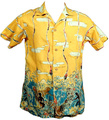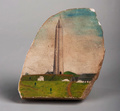This article discusses 18th-century American military buttons, noting that information on these buttons is scarce and describing the different uniforms and military buttons that were worn. It originally appeared in the January 1946 issue of American Collector magazine, a publication which ran from 1933-1948 and served antique collectors and dealers.
American military buttons of the eighteenth century are comparatively rare, and the two recently acquired New York State Militia buttons illustrated are, for me, a noteworthy addition to an all too small group of historical buttons.
The buttons are of sheffield plate, engraved by hand with the crest and motto of the State of New York; and one has the additional marking of the First Regiment. They are slightly over one and one-eighth inches in diameter and are silvered on only one side, as was quite customary among buttonmakers, even up to the time electroplating came into use.
There are eight of the First Regiment buttons and a single specimen of the other type. All the buttons in the set of eight show the slight variations characteristic of hand work, and the eagle on the other button is very different. All of them resemble doves more closely than the war-like bird they are supposed to represent.
The information readily available on the subject of military buttons is surprisingly scant, although it has been a subject of much interest for a good many years. There are several fine museum collections of which the Emilio collection in the Essex Institute of Salem, Massachusetts, the collection of the New York Historical Society gathered in field exploration expeditions under Mr. William M. Claver, and the collection of Mr. Reginald Hart, now preserved by Mr. Lightner in his Hobby Museum in Chicago are outstanding.
Captain Emilio presented his collection to the Essex Institute in 1908 and the New York Historical Society field explorations began in the early 1920’s, so interest in this phase of collecting is no new thing. The Emilio collection, which comprises 1174 military buttons, both American and foreign, shows only nine American buttons of the Revolutionary period and fewer than one hundred before 1816, although the specimens of the British army during the early period are more plentiful. The New York collection is much more complete for this period, as their finds were made by excavating on old Revolutionary camp sites.
The custom of numbering regimental buttons began as far back as 1762, when the French originated the system. Five years later British military dress regulations prescribed the use of numbered buttons; and in July of 1775 the Massachusetts Provincial Congress issued such instructions. In the fall of the same year the Continental Congress ordered the commanding officers of all state regiments to arrange with the Quartermaster General for suitably numbered buttons.
How completely this order was carried out is a question, as there were fifty-eight different state regiments serving with the Continental Army. Washington’s army was notedly a ragged group, no uniforms were provided for men serving for limited periods, and even for the regulars, the supply was far below the need. Most of the buttons used by private soldiers were cast of pewter or lead in hand molds similar to bullet molds. Often this was done by the soldiers themselves while in winter camps, and the results were very crude.
Officers fared better, and most of their buttons were of the kind made by capping a mold of bone, horn, or wood with a thin metal disc. The workmanship on such as survive of this type is excellent; the buttons are well designed and very handsome. But most if not all these buttons were made in France; and when, after about 1779, uniforms also began coming from that country the probability is that they were fastened by buttons with some sort of general service design.
In 1779, General Washington designated the type of uniform to be worn, and prescribed yellow metal buttons for the Artillery and Artillery Artificers, and white metal buttons for the Infantry and Light Dragoons. One general order of that year referring to troops raised in New York and New Jersey specifies five regiments. “Their Uniform Blue faced with Buff White Lining & Buttons, White Vests and Overalls.” The fife and drum were to wear buff faced with blue, “Trimmed with Blue Tape & Epuletts.” Five companies of artillery were to wear “Blue faced and lined with Scarlet Yellow Buttons and Tape,” their fife and drums to wear scarlet faced with blue. The Dragoons’ uniform was “Short Blue Coats, white facing & lining, white Buttons & Under Cloaths.”

Colonel Alexander McDougall, Commander of the First New York Regiment, 1775. Miniature by John Ramage.
An account rendered by the State of New York to the Continental Congress includes 974 gross coat buttons for two hundred and twenty-one Pounds, one shilling and one penny; and four gross shirt buttons for four Pounds, eleven shillings and four pence.
The First New York Regiment was from Albany County and was commanded in 1775 by Colonel Alexander McDougall. In November of 1776 Colonel Goose Van Schaick took the command, which he retained until January of 1782. Most of the militia regiments served willingly enough in home defense but were not willing to join with the Continental Army for duty farther afield. The New York First Regiment, however, was one of the units taking part in the siege of Yorktown in 1781. The State arms, of which the crest and motto, “Excelsior,” are a part, were devised in 1776 by a committee appointed by the Provincial Assembly for that purpose.
Certainly the buttons are of the type used prior to 1800. About that date, slightly earlier in England, button makers began stamping their names or at the least the quality of the buttons on the backs. Often just the word “plated” occurs.
My buttons have plain copper backs, on which no vestige of silver shows, and the hand applied shanks are all of center, as in older buttons. Both types are of the same period, and the one without the First Regiment marking could have been that of a General Officer.
This article originally appeared in American Collector magazine, a publication which ran from 1933-1948 and served antique collectors and dealers.


 Neon Lost and Found: Where New York City Still Burns Bright
Neon Lost and Found: Where New York City Still Burns Bright Spinning at 78 RPM with Record Collector Gary Herzenstiel
Spinning at 78 RPM with Record Collector Gary Herzenstiel Could an Old-School Tube Amp Make the Music You Love Sound Better?
Could an Old-School Tube Amp Make the Music You Love Sound Better? Hawaiian Style: The Roots of the Aloha Shirt
Hawaiian Style: The Roots of the Aloha Shirt The Relic Hunters Who Saved American History
The Relic Hunters Who Saved American History ButtonsAs long as human beings have needed to keep their clothing fastened, button…
ButtonsAs long as human beings have needed to keep their clothing fastened, button… Military ButtonsButtons sewn to military uniforms and worn during conflicts are among of th…
Military ButtonsButtons sewn to military uniforms and worn during conflicts are among of th… Mari Tepper: Laying it on the Line
Mari Tepper: Laying it on the Line Nice Ice: Valerie Hammond on the Genteel Charm of Vintage Canadian Costume Jewelry
Nice Ice: Valerie Hammond on the Genteel Charm of Vintage Canadian Costume Jewelry How Jim Heimann Got Crazy for California Architecture
How Jim Heimann Got Crazy for California Architecture Modernist Man: Jock Peters May Be the Most Influential Architect You've Never Heard Of
Modernist Man: Jock Peters May Be the Most Influential Architect You've Never Heard Of Meet Cute: Were Kokeshi Dolls the Models for Hello Kitty, Pokemon, and Be@rbrick?
Meet Cute: Were Kokeshi Dolls the Models for Hello Kitty, Pokemon, and Be@rbrick? When the King of Comedy Posters Set His Surreal Sights on the World of Rock 'n' Roll
When the King of Comedy Posters Set His Surreal Sights on the World of Rock 'n' Roll How One Artist Makes New Art From Old Coloring Books and Found Photos
How One Artist Makes New Art From Old Coloring Books and Found Photos Say Cheese! How Bad Photography Has Changed Our Definition of Good Pictures
Say Cheese! How Bad Photography Has Changed Our Definition of Good Pictures Middle Earthenware: One Family's Quest to Reclaim Its Place in British Pottery History
Middle Earthenware: One Family's Quest to Reclaim Its Place in British Pottery History Fancy Fowl: How an Evil Sea Captain and a Beloved Queen Made the World Crave KFC
Fancy Fowl: How an Evil Sea Captain and a Beloved Queen Made the World Crave KFC
Hello. From reading the above page, it appears there are some real experts out there who can identify military buttons. This is the purpose of my message.
I have a brass coat button with a large “4” in the center, with a ring around it, except at the top. The reverse of the button has “Extra Rich” and the button maker “M&G” (which I cannot identify either).
My question is this. Is there an email address that I can forward a couple descriptive photos of the button? This in hopes someone out there can help me correctly identify this unusual button.
Thanks for your consideration and I await the requested email address, if possible.
Regards
Charles
I’m related to that McDougall guy
I am helping a teacher identify a button for her class that a student found, but having no luck. It is a flat metal disk with a fair amount of uniform corrosion. It looked like rusted iron, but with a loop I saw a scattering of tiny drops of copper on the surface so maybe bronze? It is plain on the face and has a simple wire loop on the back that appears to be soldered on. Under the loop is the word GILT and over the loop is a crown. The crown is somewhat ornate. It shows the two bulging areas that would be fabric, each with a line of tiny dots on the edge, which would be the studded metal frame of the crown, and at the top is a small cross. It looks English, but have no found it online yet. HELP?